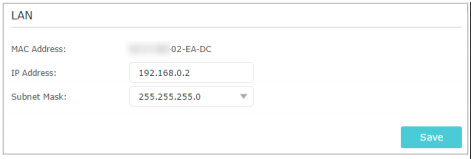How do I use the WDS Bridging function to extend my wireless network?
For example, my house covers a large area. The wireless coverage of the router I’m using (the root router) is limited. I want to use an extended router to extend the wireless network of the root router.
Note:
• WDS bridging only requires configuration on the extended router and make sure your router supports WDS. It doesn't support this feature If it can not be found on the web page with the latest firmware updated.
• WDS bridging function can be enabled either in 2.4GHz frequency or 5GHz frequency for a dual-band router. We use the WDS bridging function in 2.4GHz frequency as an example.
1. Log in to the web-based interface of the router. If you don’t know how to do that, please refer to
How to log in to the web-based interface of Wi-Fi Routers (new logo)?
2. Configure the IP address of the router:
1) Go to Advanced > Network > LAN, configure the IP address of the extended router to be in the same subnet with the root router; (For example, the IP address 101 of the root router is 192.168.0.1, the IP address of the extended router can be 192.168.0.2~192.168.0.254. We take 192.168.0.2 as an example.)
2) Click Save.
Note: Log in to the web management page again if the IP address of the router is altered.

3. Survey the SSID to be bridged:
1) Go to Advanced > System Tools > System Parameters and focus on the 2.4GHz Wireless section, click Enable WDS Bridging.
2) Click Survey, locate the root router’s SSID, and click Choose (Here we take TP-Link_4F98 as an example).
3) If the root router has a wireless password, you should enter the wireless password of the root router.
4) Click Save.
4. Disable DHCP:
1) Go to Network > DHCP Server.
2) Deselect Enable DHCP Server and click Save.
Now you can go to Advanced > Status > Wireless to check the WDS status. When the WDS status is Run, it means WDS bridging is successfully built.
Get to know more details of each function and configuration please go to Download Center to download the manual of your product.
Is this faq useful?
Your feedback helps improve this site.
TP-Link Community
Still need help? Search for answers, ask questions, and get help from TP-Link experts and other users around the world.

3.0_A_RGB_normal_1584493572647x.png)
3.0-A_normal_1584497102381x.png)